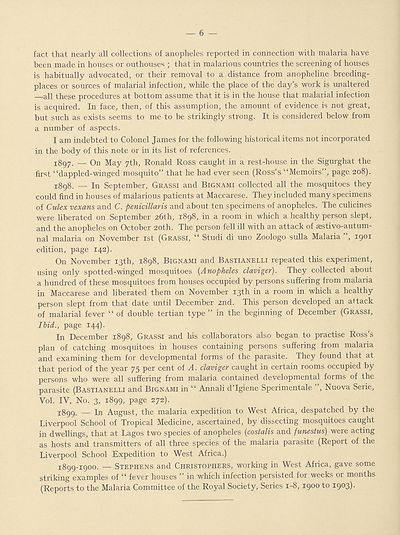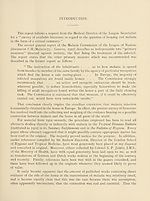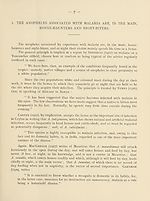Health > Housing and malaria
(8)
Download files
Complete book:
Individual page:
Thumbnail gallery: Grid view | List view

— 6 —
fact that nearly all collections of anopheles reported in connection with malaria have
been made in houses or outhouses ; that in malarious countries the screening of houses
is habitually advocated, or their removal to a distance from anopheline breeding-
places or sources of malarial infection, while the place of the day’s work is unaltered
—all these procedures at bottom assume that it is in the house that malarial infection
is acquired. In face, then, of this assumption, the amount of evidence is not great,
but such as exists seems to me to be strikingly strong. It is considered below from
a number of aspects.
I am indebted to Colonel James for the following historical items not incorporated
in the body of this note or in its list of references.
1897. — On May 7th, Ronald Ross caught in a rest-house in the Sigurghat the
first “dappled-winged mosquito” that he had ever seen (Ross’s “Memoirs”, page 208).
jggg. _ in September, Grassi and Bignami collected all the mosquitoes they
could find in houses of malarious patients at Maccarese. They included many specimens
of Culex vexans and C. penicillaris and about ten specimens of anopheles. The culicines
were liberated on September 26th, 1898, in a room in which a healthy person slept,
and the anopheles on October 20th. The person fell ill with an attack of sestivo-autum-
nal malaria on November 1st (Grassi, “ Studi di uno Zoologo sulla Malaria ’ , 1901
edition, page 142).
On November 13th, 1898, Bignami and Bastianelli repeated this experiment,
using only spotted-winged mosquitoes [Anopheles claviger). They collected about
a hundred of these mosquitoes from houses occupied by persons suffering from malaria
in Maccarese and liberated them on November 13th in a room in which a healthy
person slept from that date until December 2nd. This person developed an attack
of malarial fever “ of double tertian type ” in the beginning of December (Grassi,
I hid., page 144).
In December 1898, Grassi and his collaborators also began to practise Ross’s
plan of catching mosquitoes in houses containing persons suffering from malaria
and examining them for developmental forms of the parasite. They found that at
that period of the year 75 per cent of A. claviger caught in certain rooms occupied by
persons who were all suffering from malaria contained developmental forms of the
parasite (Bastianelli and Bignami in “ Annali d’lgiene Sperimentale ’ , Nuova Serie,
Vol. IV, No. 3, 1899, page 272).
i899. — In August, the malaria expedition to West Africa, despatched by the
Liverpool School of Tropical Medicine, ascertained, by dissecting mosquitoes caught
in dwellings, that at Lagos two species of anopheles (costalis and junestus) were acting
as hosts and transmitters of all three species of the malaria parasite (Report of the
Liverpool School Expedition to West Africa.)
1899-1900. — Stephens and Christophers, working in West Africa, gave some
striking examples of “ fever houses ” in which infection persisted for weeks or months
(Reports to the Malaria Committee of the Royal Society, Series 1-8, 1900 to 1903).
fact that nearly all collections of anopheles reported in connection with malaria have
been made in houses or outhouses ; that in malarious countries the screening of houses
is habitually advocated, or their removal to a distance from anopheline breeding-
places or sources of malarial infection, while the place of the day’s work is unaltered
—all these procedures at bottom assume that it is in the house that malarial infection
is acquired. In face, then, of this assumption, the amount of evidence is not great,
but such as exists seems to me to be strikingly strong. It is considered below from
a number of aspects.
I am indebted to Colonel James for the following historical items not incorporated
in the body of this note or in its list of references.
1897. — On May 7th, Ronald Ross caught in a rest-house in the Sigurghat the
first “dappled-winged mosquito” that he had ever seen (Ross’s “Memoirs”, page 208).
jggg. _ in September, Grassi and Bignami collected all the mosquitoes they
could find in houses of malarious patients at Maccarese. They included many specimens
of Culex vexans and C. penicillaris and about ten specimens of anopheles. The culicines
were liberated on September 26th, 1898, in a room in which a healthy person slept,
and the anopheles on October 20th. The person fell ill with an attack of sestivo-autum-
nal malaria on November 1st (Grassi, “ Studi di uno Zoologo sulla Malaria ’ , 1901
edition, page 142).
On November 13th, 1898, Bignami and Bastianelli repeated this experiment,
using only spotted-winged mosquitoes [Anopheles claviger). They collected about
a hundred of these mosquitoes from houses occupied by persons suffering from malaria
in Maccarese and liberated them on November 13th in a room in which a healthy
person slept from that date until December 2nd. This person developed an attack
of malarial fever “ of double tertian type ” in the beginning of December (Grassi,
I hid., page 144).
In December 1898, Grassi and his collaborators also began to practise Ross’s
plan of catching mosquitoes in houses containing persons suffering from malaria
and examining them for developmental forms of the parasite. They found that at
that period of the year 75 per cent of A. claviger caught in certain rooms occupied by
persons who were all suffering from malaria contained developmental forms of the
parasite (Bastianelli and Bignami in “ Annali d’lgiene Sperimentale ’ , Nuova Serie,
Vol. IV, No. 3, 1899, page 272).
i899. — In August, the malaria expedition to West Africa, despatched by the
Liverpool School of Tropical Medicine, ascertained, by dissecting mosquitoes caught
in dwellings, that at Lagos two species of anopheles (costalis and junestus) were acting
as hosts and transmitters of all three species of the malaria parasite (Report of the
Liverpool School Expedition to West Africa.)
1899-1900. — Stephens and Christophers, working in West Africa, gave some
striking examples of “ fever houses ” in which infection persisted for weeks or months
(Reports to the Malaria Committee of the Royal Society, Series 1-8, 1900 to 1903).
Set display mode to:
![]() Universal Viewer |
Universal Viewer | ![]() Mirador |
Large image | Transcription
Mirador |
Large image | Transcription
Images and transcriptions on this page, including medium image downloads, may be used under the Creative Commons Attribution 4.0 International Licence unless otherwise stated. ![]()
| League of Nations > Health > Housing and malaria > (8) |
|---|
| Permanent URL | https://digital.nls.uk/191817602 |
|---|
| Shelfmark | LN.III |
|---|---|
| Description | Over 1,200 documents from the non-political organs of the League of Nations that dealt with health, disarmament, economic and financial matters for the duration of the League (1919-1945). Also online are statistical bulletins, essential facts, and an overview of the League by the first Secretary General, Sir Eric Drummond. These items are part of the Official Publications collection at the National Library of Scotland. |
|---|---|
| Additional NLS resources: |
|

